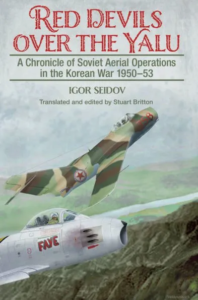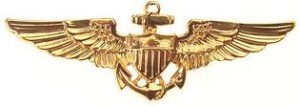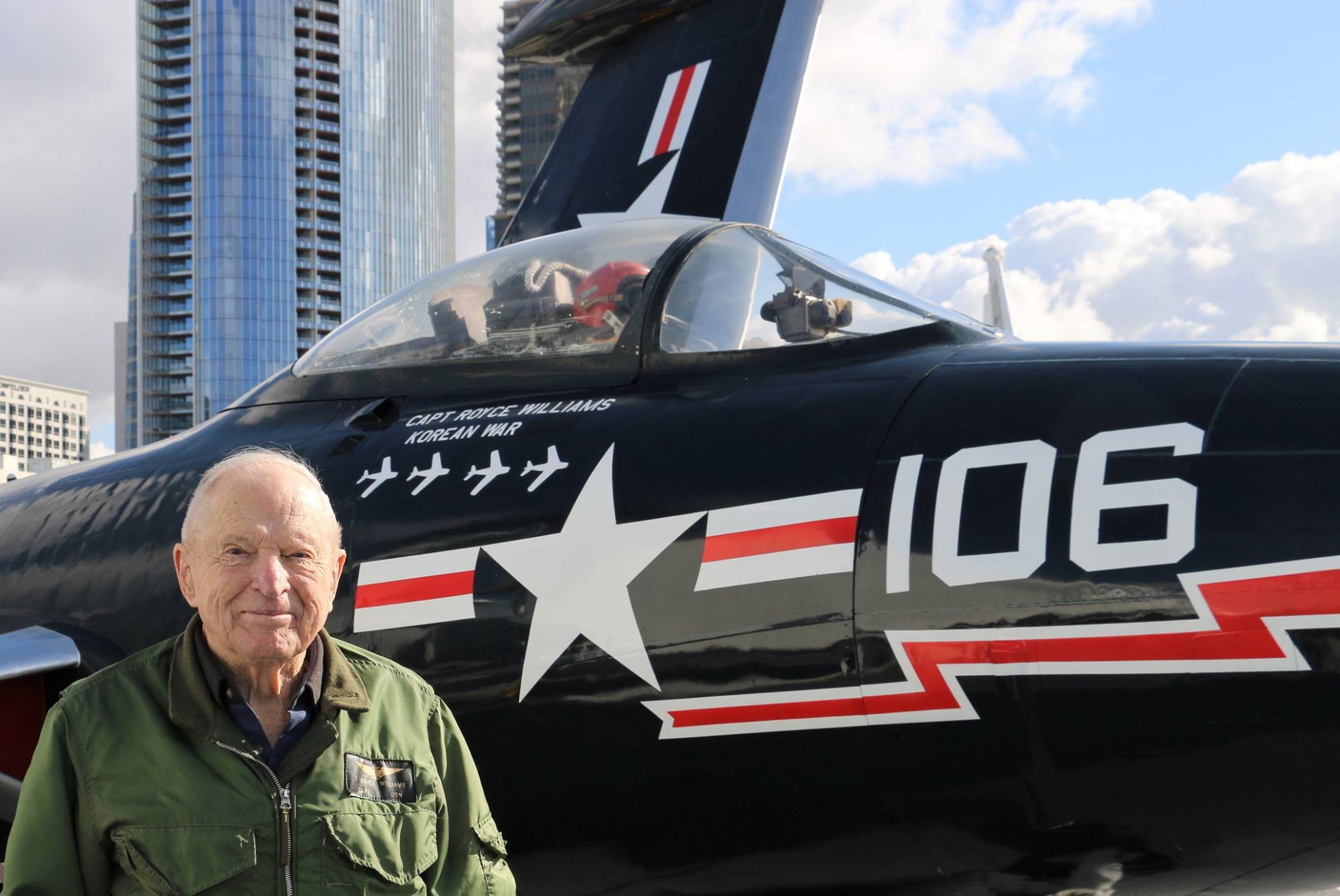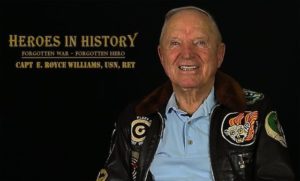Testimony of Pilot #33
Will he finally receive the Medal of Honor?
In San Diego Harbor on the USS Midway, now a museum ship , Capt. Royce Williams (USN, Ret) stands next to an F9F Panther with the silhouettes of four MiGs under the cockpit. The aircraft and its markings are there as a tribute to the man who downed at least four Russian MiGs in an extraordinary 35+ minutes on one mission on Nov. 18, 1952.
For over half a century his achievement was classified; nobody knew what he did that day over the skies of Korea. If you don’t know his story please see Part One.
Now retired he is one of the Korean War’s forgotten heroes. Royce Williams’ heroics in the Korean War flew under the radar for more than a half-century. Now, after his heroic engagement with seven Soviet MiG 15s – kept secret for decades – the 97-year-old retired Navy captain could be in line for the Medal of Honor based on a movement, sponsored by a U.S. Senator and several Navy flag officers.
Royce Williams accomplished what no other American fighter pilot would ever accomplish: shoot down four MiG-15s in one fight. Given that the F9F-5 Panther was outclassed and outperformed on all points by the MiG-15 – speed (nearly 100mph faster), superior thrust-to-weight ratio, maneuverability and firepower – it was truly a performance for the record books.
This was the only time that a US Pilot in a US aircraft engaged Soviet pilots in Soviet aircraft during the Korean War, and was covered up for decades due to the tense political environment of the Cold War. The event was immediately declared Top Secret and Williams was directed by the Navy to not reveal the incident.
There were more than 250,000 sorties flown by the Navy during the Korean conflict, and classification or not the ensuing engagement would end in one of the great feats of aerial combat.
There is now an effort underway to see him awarded the Medal of Honor for his actions that day.
******
There was real fear at the highest levels of the US government and UN command that such an “incident” could change the Korean “police action” into World War III. The national security implications of the encounter began to take hold. While Soviet volunteers were known to be flying in Korea, Williams had engaged the actual Soviet Air Force. Furthermore, his flight had been made aware of the Soviet jets based on intelligence from a small detachment from the National Security Agency — then less than a year old — operating on one of the other ships in the task force. As far as the United States Navy was concerned, the fight had to have never happened.
After ordering Williams to tell no one, Vice Admiral Robert P. Briscoe, Commander Naval Forces Far East, did inform him the NSA team had proof from recorded radio transmissions that indeed he had gotten at least three of the MiGs, while the fourth had crashed in Siberia. Unfortunately, the gun camera footage had been “edited” aboard Oriskany, leaving only a portion showing two MiGs hit solidly.
Rather than acknowledge an air battle that might have had the effect of drawing the Soviets into the Korean War, National Security Agency and Naval commanders ordered a version of the mission created that became the “official account” as found in the Oriskany and Air Group 102 Action Reports, though it had little connection with the facts. Both planes’ gun camera footage was immediately taken by the intelligence officers and later, Williams learned, was passed along to the newly formed National Security Agency.
The dogfight scrubbed from its records and Williams sworn to secrecy for more than 50 years, when the nation awarded 146 Medals of Honor to U.S. servicemen for extraordinary valor in the Korean War, Williams didn’t make the list.
He was credited with one kill and a probable/damaged while Ltjg John Middleton was credited with a kill on the basis that, at the end of the 35-minute fight when vectored back from Oriskany toward a descending MIG, the pilot had ejected when Middleton approached it and fired a burst from out of range. As the wingman to the division leader who had been forced to return to the Oriskany by mechanical problems he had never been anywhere near the real fight. Both pilots were awarded the Silver Star for their “accomplishments.” Dave Rowlands, who never fired a shot in the entire fight, was awarded a probable and the Distinguished Flying Cross. The history books have told the story that way ever since.
Williams went on to fly a total of 70 missions during the Korean War, later flying F-8 Crusaders and commanded VF-33 and Carrier Wing 11. He flew 110 missions during a Vietnam deployment as the “CAG,” retiring as a Captain (O-6) in 1980.
The only official record of the engagement is Williams’ one confirmed kill and a Silver Star. His aerial heroics have been a legend for decades among pilots coming up through the Navy’s Top Gun school. But no trace of Williams’ daring flight on Nov. 18, 1952, exists in the U.S. military archives.
*****************
For decades, as noted, the entire incident itself remained shrouded in mystery but over the years, pieces of the story began to emerge. In 1992, with the collapse of the Soviet Union, records began to emerge from Moscow confirming the engagement. The Russians opened records that revealed that Williams had indeed gotten four kills: Captain Belyakov, Captain Vandalov, Lt Pakhomkin and Lt Tarshinov of the VVS-PVO, the Air Defense Forces of the Red Air Force. Vandalov, Pakhomkin and Tarshinov were directly shot down in the fight, while flight leader Belyakov was badly shot up and was killed when he attempted to crash-land as soon as he was over Soviet territory.
Other unconfirmed reports surfaced that the Soviet’s actually lost six airplanes in the encounter. A fifth crashed in Soviet territory as it was limping home. Another aircraft and pilot were listed as MIA because the plane never returned to its base. All six were members of Soviet Naval Aviation.
True to his word, Williams although long since retired, had refused to discuss the dogfight. He had never told anyone about the dogfight — not even his wife, Camilla, or his pilot brother until the Russians released the downed pilots names.
But while Williams thus became the top-scoring carrier-based naval aviator and the top-scoring naval aviator in a Navy jet in the Korean War, several attempts to set the record straight have failed. The problem persists on the grounds that there is no longer an American witness alive to verify Williams’ account, this despite the Russian publication of the names of the Soviet pilots who died in the fight.
The dogfight has now been covered in a 2014 book by Russian historian Igor Seidov, “Red Devils Over the Yalu: A Chronicle of Soviet Aerial Operations in the Korean War.”
Devils Over the Yalu: A Chronicle of Soviet Aerial Operations in the Korean War.”
He wrote that of the seven MiGs that left Vladivostik that morning, only one returned to base. Four were shot down by a single U.S. aircraft, one plane was shot up and crashed on its way back and the seventh plane was never found.
There’s now a long-simmering campaign for Williams to receive the Medal of Honor. But because the incident officially didn’t happen, finding the necessary documentation is still an uphill battle. Nominations for the Medal of Honor are required within three years of the event. Any later nomination requires Congressional action.
Over the past eight years, after reading Seidov’s book, retired Rear Adm. Doniphan “Don” Shelton of Del Mar has tried repeatedly to get the Navy and Department of Defense to award the medal to Williams, but by not involving Congress members early enough in the process to receive a congressionally awarded medal, Shelton’s efforts ultimately failed and last October Shelton passed away .
A newly assembled delegation’s effort, nicknamed “Operation Just Reward,” is now seen as the last chance to get the medal to Williams before he passes away.
Navy veteran Steve Lewandowski who assisted Shelton’s efforts for three years has gathered signatures supporting the action from nearly 100 Navy, Marine, and Army flag officers, as well as resolutions from the American Legion and Distinguished Flying Cross Association. All five members of the San Diego U.S. Congressional delegation have joined forces to not only bring Williams’ heroism to the public’s attention, but also to right what they see as a historic wrong. Congress members Darrell Issa, Scott Peters, Sara Jacobs, Juan Vargas and Mike Levin have prepared an amendment to the 2023 National Defense Authorization Act to include the Medal of Honor for Williams,
“To me and everyone who learns his story, Royce Williams is more than the Navy’s Top Gun pilot for all time,” said Rep. Issa who initially proposed a bill to award Williams the Medal of Honor last fall and sponsored the House NDAA amendment. “His courage under fire and service to our country in a time of war should be an inspiration for all Americans. While Royce seeks neither fame nor recognition, those of us who know him and know what he did won’t give up until our mission to honor him is a success.”
“Royce Williams is a hero like no other, and his uncommon valor and resolute courage in battle is a history everyone should know,” Issa continued. “His recognition with the Medal of Honor is overdue and we’re going to get it done.” But even with the support of the bipartisan delegation, the medal award is no sure thing. Lewandowski said there are still hurdles to overcome, as the Navy and Department of Defense have already twice rejected the application. He hopes the battle for the medal can now be fought in the court of public opinion and the bipartisan coalition’s support will turn the tide.
“This is it, ‘once more unto the breach.’ It’s a ragtag, zero-resources effort, but it’s the right thing to do. This old man needs to be recognized for this unbelievable dogfight, when quite frankly anyone else would’ve run the other way. He’s the real Top Gun,” said Lewandowski, who is past commander of American Legion Post 416 in Encinitas.
Now 97 and long retired, Williams lives in a scenic mountainside home in Escondido’s Hidden Meadows community. Spinal injuries from a long-ago plane crash in El Centro make it hard for Williams to maneuver around his home, but his memory of the 1952 dogfight remains as fresh today as it was seven decades ago. Asked how it would feel to be awarded the Medal of Honor now, Williams takes a few seconds to consider his answer.
“If it happened, I would be awed,” Williams said. “I wish my dad could know. It would mean even more to my friends to know that I finally received it.”
****************
The House has passed the version of the FY 2023 National Defense Authorization Act (NDAA) that includes the amendment authorizing the award of the highest military award for valor to Williams for the California resident’s courageous actions against such long odds on November 18, 1952.
The Senate version has yet to go through that chamber’s full amendment process.
Actions Speak Louder Than Medals – the Royce Williams Story – https://www.youtube.com/watch?v=q0RzrNkx4iQ 







